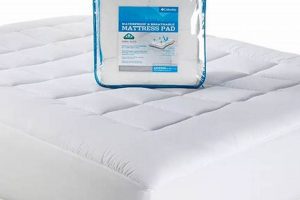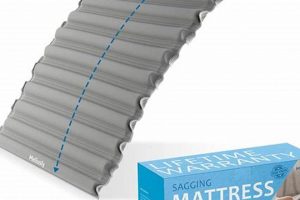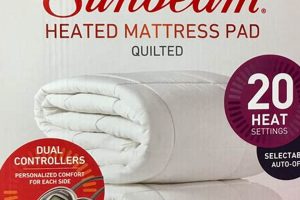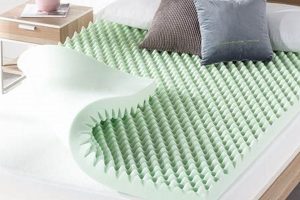A protective bedding layer, designed to encase a mattress, serves as a barrier against allergens such as dust mites, pet dander, and pollen. This bedding accessory aims to minimize exposure to these common triggers during sleep. For instance, individuals with respiratory sensitivities often use this type of bedding to reduce nighttime allergy symptoms.
Utilizing such a protective layer can contribute to improved sleep quality by reducing allergen-induced disruptions. Its historical context is rooted in the growing awareness of indoor air quality and its impact on health, leading to the development of textiles engineered to mitigate allergen exposure. The benefits extend beyond symptom management, potentially creating a cleaner sleeping environment.
The subsequent sections will delve into the materials and construction commonly employed in crafting these protective layers, exploring their maintenance requirements, and assessing their effectiveness in managing allergy symptoms. Further discussion will cover factors to consider when selecting a suitable option and comparing different products available on the market.
Guidance on Selecting and Utilizing Protective Mattress Layers
This section provides essential guidelines for individuals considering the incorporation of a protective mattress layer into their sleep environment. Proper selection and use are crucial for maximizing the benefits of allergen control.
Tip 1: Material Selection: Prioritize tightly woven fabrics, ideally with a pore size small enough to block dust mites and other allergens. Consider materials certified by reputable allergy and asthma foundations.
Tip 2: Encasement Design: Opt for a full encasement design, which completely surrounds the mattress on all sides. This provides a comprehensive barrier against allergens migrating from within the mattress.
Tip 3: Zipper Security: Ensure the zipper is robust and features a locking mechanism. This prevents accidental openings that could compromise the protective barrier.
Tip 4: Regular Laundering: Adhere to the manufacturer’s instructions for laundering. Wash the protective layer regularly in hot water (at least 130F or 54C) to eliminate accumulated allergens.
Tip 5: Avoid Harsh Chemicals: Refrain from using harsh chemicals or bleach when laundering, as these can damage the fabric and reduce its effectiveness.
Tip 6: Mattress Age: Consider replacing a very old mattress. A new protective layer will be more effective when applied to a relatively clean and allergen-free mattress core.
Tip 7: Professional Cleaning: For mattresses that are not new, consider professional cleaning prior to encasing them with a protective layer. This removes existing allergen buildup.
Adhering to these guidelines enhances the efficacy of a protective mattress layer in minimizing allergen exposure and promoting a healthier sleep environment. The key lies in selecting a high-quality product and maintaining it properly.
The following section will address common misconceptions surrounding the use of protective mattress layers and provide clarity on their realistic benefits.
1. Material pore size
Material pore size is a critical determinant of an allergy mattress pad’s efficacy in preventing allergen exposure. The cause-and-effect relationship is straightforward: larger pore sizes permit the passage of allergens, such as dust mites and their detritus, through the fabric and into the sleeping environment. Conversely, smaller pore sizes restrict allergen movement, maintaining a cleaner surface for the sleeper. The importance of pore size stems from its direct influence on the pad’s ability to function as a barrier. For example, a mattress pad constructed of loosely woven cotton, with a large pore size, will offer minimal protection against dust mites, despite being marketed as hypoallergenic. Conversely, tightly woven microfiber fabrics with pore sizes less than 10 microns are demonstrably effective at blocking these common allergens. This understanding is practically significant, allowing consumers to prioritize products with proven barrier capabilities, supported by scientific studies measuring fabric permeability.
Further analysis reveals that the measurement and standardization of pore size are essential for reliable product evaluation. Several organizations, such as the Asthma and Allergy Foundation of America (AAFA), offer certification programs based on stringent testing criteria, including pore size assessment. Products bearing these certifications provide consumers with a degree of assurance regarding their barrier performance. Practical applications of this knowledge extend to clinical settings, where healthcare providers often recommend specific mattress pad materials and pore sizes to patients with diagnosed allergies or asthma. Selection of the appropriate pore size is also dependent on the specific allergens a person is sensitive to. For instance, pet dander particles are typically larger than dust mite allergens and thus, may be blocked by a less restrictive weave, though optimal protection always necessitates a tightly woven fabric.
In summary, material pore size is a key performance indicator for an allergy mattress pad, directly influencing its ability to minimize allergen exposure. Challenges include the lack of universal standards for pore size measurement across manufacturers and the potential for reduced breathability in extremely tightly woven fabrics. However, understanding the importance of pore size empowers consumers to make informed choices, selecting products that demonstrably improve the sleep environment and reduce allergy symptoms. The connection between pore size and the pad’s intended function is undeniable, reinforcing the need for stringent quality control and transparent product labeling within the industry.
2. Full encasement design
The full encasement design represents a pivotal feature in the functionality of an allergy mattress pad. A cause-and-effect relationship is evident: a design that completely encloses the mattress prevents allergens residing within the mattress from escaping into the sleep environment, thereby reducing exposure. Conversely, partial encasements or those lacking complete closure allow allergens to permeate, negating the pad’s intended benefit. The importance of a full encasement lies in its comprehensive barrier. Real-life examples highlight this effectiveness; individuals with severe dust mite allergies often experience symptom reduction only when using mattress pads that fully encase the mattress, as opposed to those that merely cover the top surface. This understanding has practical significance in enabling consumers to make informed decisions, recognizing that complete enclosure is paramount for optimal allergen control.
Further analysis reveals that the integrity of the closure mechanism, typically a zipper, is integral
to maintaining the full encasement’s efficacy. A compromised zipper, even a small opening, provides a point of egress for allergens. For instance, a study observing allergen levels in the sleeping areas of allergy sufferers found that homes using fully encased mattresses with secure zippers exhibited significantly lower dust mite concentrations compared to homes using alternative mattress protection methods. Practical applications extend to the development of specialized zippers with locking mechanisms that prevent accidental openings. Also, understanding the impact on the zipper can lead to an increased awareness of maintaining the zipper by ensuring that it opens and closes smoothly. Maintaining zipper health can extend the life of an allergy mattress pad.
In summary, the full encasement design is a critical component of an allergy mattress pad, directly influencing its ability to minimize allergen exposure. Challenges exist in ensuring consistent manufacturing quality and durability of the encasement and its closure. However, recognizing the importance of complete enclosure allows consumers to prioritize products that offer superior protection and contribute to improved sleep quality for allergy sufferers. The connection between the design and the pad’s intended function underscores the need for rigorous testing and certification standards within the bedding industry.
3. Zipper locking mechanism
The integrity of an allergy mattress pad’s allergen barrier is contingent upon the security of its closure. The zipper locking mechanism, a critical component of this closure, directly influences the pad’s effectiveness in preventing allergen migration.
- Prevention of Inadvertent Opening
A zipper locking mechanism safeguards against accidental zipper displacement. Unintentional openings, however small, compromise the encasement’s seal, permitting the egress of dust mites and other allergens. A locking mechanism, therefore, provides a mechanical means of securing the zipper pull, preventing movement resulting from friction or shifting during sleep. This feature translates directly to a more consistent and reliable allergen barrier.
- Durability and Longevity
The presence of a locking mechanism can contribute to the overall lifespan of the zipper itself. By minimizing stress on the zipper teeth and slider due to unintended movement, the mechanism reduces the likelihood of zipper failure. This increased durability results in a longer-lasting and more effective allergy mattress pad, mitigating the need for frequent replacements.
- Enhanced Barrier Integrity
Zipper locking mechanisms are often designed to create a tighter seal than standard zippers. This may involve features such as overlapping fabric flaps or specialized zipper teeth designed to interlock more securely. These enhancements contribute to a more impermeable barrier, further reducing the potential for allergen leakage and maximizing the protective benefits of the mattress pad.
- Ease of Maintenance
While primarily focused on security, some locking mechanisms are designed for user convenience. Easy-to-operate locking features encourage proper closure after laundering or mattress adjustments. A cumbersome or difficult-to-use locking mechanism may lead to inconsistent use, negating its intended protective benefits.
The zipper locking mechanism, therefore, represents a seemingly small but crucial element in the overall design and function of an allergy mattress pad. Its presence contributes significantly to the reliability, durability, and user-friendliness of the product, directly impacting its effectiveness in creating a healthier sleep environment. The selection of a mattress pad should include careful consideration of the quality and functionality of its zipper locking mechanism.
4. Regular laundering
Regular laundering is a critical maintenance procedure that directly impacts the efficacy of an allergy mattress pad in mitigating allergen exposure. The accumulation of allergens on the pad’s surface necessitates periodic cleaning to maintain its protective properties.
- Allergen Removal
The primary function of regular laundering is the removal of accumulated allergens, such as dust mites, pet dander, pollen, and mold spores. Over time, these substances become embedded in the fabric fibers, potentially negating the pad’s barrier properties. Regular washing with hot water (ideally above 130F or 54C) effectively eliminates these allergens, preventing their re-introduction into the sleeping environment. An example includes individuals experiencing decreased allergy symptoms after establishing a routine of bi-weekly washing of their mattress pads.
- Dust Mite Control
Dust mites, a common trigger for allergic reactions, thrive in bedding materials. Regular laundering disrupts their life cycle and removes their fecal matter, a potent allergen. Consistent washing, therefore, plays a crucial role in controlling dust mite populations within the sleep environment. A study indicated that washing bedding weekly reduces dust mite allergen levels by as much as 90%.
- Prevention of Mold Growth
Moisture accumulation within a mattress pad can create an environment conducive to mold growth. Regular laundering not only removes existing mold spores but also helps to prevent their proliferation by removing moisture and organic matter that serve as a food source. Failing to regularly wash a mattress pad in humid climates can lead to mold growth and exacerbate respiratory issues.
- Maintaining Fabric Integrity
While the primary purpose is allergen removal, regular laundering also contributes to the maintenance of the fabric’s integrity. The removal of accumulated dirt and debris prevents fiber degradation and prolongs the lifespan of the mattress pad. Neglecting regular washing can lead to the breakdown of the fabric, compromising its barrier function and requiring premature replacement.
The practice of regular laundering, therefore, represents an essential component in maximizing the benefits of an allergy mattress pad. It ensures the continued effectiveness of the pad as an allergen barrier, contributing to a cleaner and healthier sleep environment. Failure to adhere to a regular washing schedule can compromise the pad’s protective capabilities and negate its intended purpose. Frequency should be determined by individual allergy severity and environmental factors, but consistent adherence to a laundering routine is paramount.
5. Certified materials
The use of certified materials in the construction of allergy mattress pads is a critical determinant of their efficacy and safety for individuals with sensitivities. Certification programs provide assurance that a product has undergone rigorous testing and meets specific standards for allergen reduction and material safety. This validation process offers consumers a degree of confidence in the pad’s ability to perform as intended.
- Reduced Allergen Content
Certification programs often m
andate limits on the presence of allergenic substances within the mattress pad’s materials. For example, certifications may restrict the use of certain dyes, chemicals, or flame retardants known to trigger allergic reactions. The Oeko-Tex Standard 100 certification, for instance, tests for hundreds of harmful substances to ensure that the fabric is safe for human contact. This directly benefits individuals with chemical sensitivities who may react adversely to non-certified materials. - Dust Mite Barrier Verification
Some certifications specifically address the ability of the mattress pad to act as a barrier against dust mites, a common household allergen. These programs test the pore size and weave density of the fabric to ensure that it effectively prevents dust mites from penetrating the mattress. The Asthma and Allergy Foundation of America (AAFA) certification, for example, requires products to meet stringent standards for allergen impermeability. This is crucial for individuals with dust mite allergies seeking to minimize their exposure during sleep.
- Material Durability and Longevity
Certification processes often include assessments of material durability and resistance to wear and tear. A certified mattress pad is more likely to withstand repeated laundering and maintain its structural integrity over time. Certifications may assess factors such as fabric strength, seam integrity, and zipper quality. A durable product provides a longer-lasting allergen barrier and reduces the need for frequent replacements, offering economic and environmental benefits.
- Transparency and Traceability
Certification programs promote transparency in the manufacturing process by requiring detailed information about the materials used and their sources. This traceability allows consumers to make informed choices about the products they purchase and supports responsible manufacturing practices. Some certifications also verify that the materials are produced in an environmentally sustainable manner. This appeals to environmentally conscious consumers who seek products that align with their values.
The incorporation of certified materials in allergy mattress pads provides a multifaceted assurance of quality, safety, and performance. These certifications offer consumers a valuable tool for selecting products that effectively minimize allergen exposure and promote a healthier sleep environment. The certification marks serve as a visual cue that the product has undergone independent testing and meets established standards for allergen control and material safety, reinforcing consumer trust and confidence.
6. Mattress age
Mattress age significantly impacts the effectiveness of an allergy mattress pad. As mattresses age, they accumulate allergens, including dust mites, mold spores, and skin cells, within their structure. This buildup can compromise the functionality of even the most effective allergy mattress pad, necessitating consideration of the mattress’s age when implementing allergen control strategies.
- Accumulation of Allergen Reservoirs
Over time, mattresses become reservoirs for allergens. Dust mites, for example, thrive in the warm, humid environment of a mattress and their populations can increase exponentially with age. An older mattress, therefore, presents a higher concentration of allergens that can migrate through even a high-quality allergy mattress pad if the encasement is not perfectly sealed or if the mattress itself is disturbed. This requires more frequent and thorough cleaning of both the mattress pad and the surrounding sleep environment.
- Deterioration of Mattress Material
As mattresses age, their internal materials degrade, creating more crevices and spaces for allergens to accumulate. Foam can break down, springs can lose their tension, and fabric can wear thin. This deterioration not only increases the surface area available for allergen colonization but also makes the mattress more susceptible to allergen penetration. An allergy mattress pad alone may not be sufficient to address the underlying issue of a structurally compromised mattress.
- Reduced Effectiveness of Cleaning Efforts
Older mattresses are more difficult to clean effectively. Surface cleaning may remove some allergens, but it cannot penetrate deep into the mattress core where the majority of allergens reside. Even professional cleaning methods may not be able to fully eliminate the accumulated allergens within an aged mattress. This reduced effectiveness of cleaning efforts necessitates a more comprehensive approach to allergen control, potentially including mattress replacement.
- Impact on Allergic Symptoms
The age of a mattress can directly impact the severity of allergic symptoms. Individuals with allergies may experience increased respiratory distress, skin irritation, or sleep disturbances when sleeping on an older, allergen-laden mattress, even when using an allergy mattress pad. The continuous exposure to high levels of allergens can overwhelm the protective barrier provided by the mattress pad and exacerbate allergic reactions. This necessitates a proactive approach to mattress maintenance and replacement to minimize allergen exposure and improve overall health.
In conclusion, mattress age is a critical factor to consider when implementing allergen control strategies. While an allergy mattress pad can provide a valuable barrier against allergens, its effectiveness is limited by the age and condition of the underlying mattress. Regular mattress maintenance, including cleaning and eventual replacement, is essential for minimizing allergen exposure and optimizing the benefits of an allergy mattress pad. Failing to address the issue of mattress age can undermine the effectiveness of even the most advanced allergen control measures.
Frequently Asked Questions
This section addresses common inquiries regarding allergy mattress pads, providing detailed information to clarify their purpose, functionality, and limitations.
Question 1: What constitutes an effective allergy mattress pad?
An effective product incorporates a tightly woven fabric with a pore size sufficient to block dust mites and other common allergens. Full encasement designs with secure zippers are paramount for complete protection.
Question 2: How frequently should an allergy mattress pad undergo laundering?
Laundering frequency depends on individual allergy severity and environmental factors. However, a bi-weekly washing schedule in hot water (above 130F or 54C) is generally recommended to eliminate accumulated allergens.
Question 3: Can an allergy mattress pad eliminate pre-existing allergens within a mattress?
An allergy mattress pad acts as a barrier, preventing allergens from escaping. It does not eliminate existing allergens. Mattresses should undergo professional cleaning before encasement, or ideally, a new mattress should be used.
Question 4: Do all mattress pads marketed as “allergy” offer equal protection?
No. The protective capabilities vary. Look for certifications from reputable organizations, such as the Asthma and Allergy Foundation of America (AAFA), indicating adherence to stringent testing criteria.
Question 5: Is an allergy mattress pad sufficient for managing severe allergies?
While beneficial, it is often part of a broader allergy management strategy. Additional measures, such as air purifiers, alle
rgen-proof pillow covers, and regular house cleaning, may be necessary for comprehensive control.
Question 6: How does mattress age influence the effectiveness of an allergy mattress pad?
Older mattresses accumulate significantly more allergens, potentially overwhelming the pad’s protective capabilities. Replacing old mattresses is recommended for optimal allergen control.
The effectiveness of an allergy mattress pad hinges on proper selection, maintenance, and integration into a broader allergy management plan. Understanding its limitations and maximizing its potential is crucial for symptom mitigation.
The subsequent section will provide a comparative analysis of different types of allergy mattress pads, highlighting their respective advantages and disadvantages.
In Conclusion
This exploration of the allergy mattress pad underscores its role as a crucial tool in managing allergen exposure within the sleep environment. Key considerations, including material pore size, full encasement design, secure zipper mechanisms, and regular laundering, significantly influence its effectiveness. Certified materials offer an added layer of assurance, while acknowledging mattress age remains essential for optimizing overall allergen control.
The informed selection and diligent maintenance of an allergy mattress pad contribute to a reduction in allergen-induced sleep disruptions. While not a singular solution for all allergy sufferers, its integration into a comprehensive allergen management strategy holds considerable significance. Continued research and development within the bedding industry will likely yield further advancements, refining the design and enhancing the protective capabilities of these critical bedding components.







